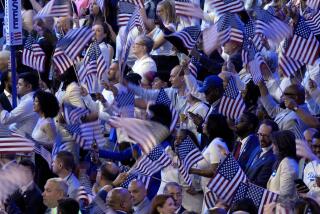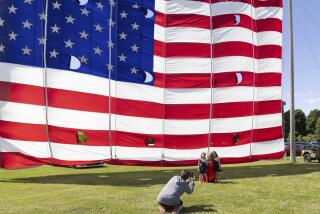Flag Day and U.S. Flag History
- Share via
Whether it’s planted on the moon by astronauts, carried into stadiums by Olympic athletes or flown from front porches by families, the U.S. flag is an important national symbol that is remembered each Flag Day, June 14. Many flags have served as signposts in the nation’s history, and they have inspired hope and patriotism as well as revolution and controversy. Discover how U.S. flags have expressed the spirit and the politics of their times through the direct links on The Times Launch Point Web site: https://www.latimes.com/launchpoint
Level 1
History at Flag Day Festival: Schoolteacher B.J. Cigrand is believed to have established Flag Day, which was celebrated by the students of Fredonia, Wis., Public School, District 6, on June 14, 1885. Visit the flag gallery, learn how to cut a five-pointed star in just one snip, and read about Francis Hopkinson, who came up with the idea of using stars and stripes.
https://www.flagday.com/history/
Betsy Ross Home Page: The Rev. Jesse Jackson once said, “Our flag is red, white and blue, but our nation is a rainbow--red, yellow, brown, black and white--and we’re all precious in God’s sight.” Read other thoughts about the flag as you review historical evidence suggesting that Betsy Ross did indeed sew the first American flag, in 1776, as well as learn flag history and etiquette.
https://www.ushistory.org/betsy/index.html
Star Spangled Banner History: The Star Spangled Banner sewn by Mary Pickersgill and her daughter Caroline measured 30 feet by 42 feet and weighed 50 pounds. View archival photos that detail the role of this flag at Fort McHenry, learn about this flag being displayed during the first U.S. Flag Day celebration in 1877 and test your knowledge with an interactive quiz.
https://www.tdo.com/local/graphics/ssbh/ssbh.htm
Level 2
American Flags Gallery: On June 14th, 1777, the Continental Congress adopted a resolution: “That the flag of the thirteen United States be thirteen stripes alternate red and white; that the union be thirteen stars, white on a blue field, representing a new constellation.” Learn about the history behind the design of the U.S. flag and find out how President Taft finally set more specific design standards in 1912 because so many versions of the flag were developed.
https://acanthus.net/flag/index.html
The Star Spangled Banner: Francis Scott Key was so inspired when he saw the flag still flying after a 25-hour battle with the British at Fort McHenry that he wrote a poem that later became the lyrics to our national anthem. View the actual Star Spangled Banner, learn about how the U.S. flag has changed over the years and try your hand at being a historian by using primary sources to solve mysteries about this famous flag.
https://americanhistory.si.edu/ssb/
Consumer Information Center: Our Flag: It was Samuel C. Reid of the Navy who suggested that the flag have 13 stripes to represent the 13 colonies, and that a star be added for each new state coming into the union. Learn more about flags and the symbolism used in flags in various periods.
https://www.pueblo.gsa.gov/cic_text/misc/ourflag/titlepage.htm
Level 3
The Flag of the United States of America: How did the flag become known as “Old Glory”? What are the rules behind flying a flag at half-staff? Learn about flags and their role in history through this collection of articles, illustrations and facts.
https://www.usflag.org
Flags of the World: United States of America: This extensive collection of U.S. flag pictures and facts details the evolution of the Stars and Stripes as well as a large number of historical, commemorative, military, political and cultural flags.
https://fotw.digibel.be/flags/us.html
Encarta: Flag of the United States: Learn how the colonial American flags were first influenced and then departed from the design of the British Union Jack, and learn about historic events that led to the development of today’s flag.
https://encarta.msn.com/find/Concise.asp?z=1&pg;=2&ti;=761577016
EXPLORER’S QUEST
The answer to this Internet quiz can be found in the sites at right.
Who thought the first U.S. flag should have six-pointed stars?
CLUE: See History at Flag Day Festival
Find What You Need to Know: Have a project on California history? Need help doing a math problem? Launch Point covers more than 100 topics for getting your schoolwork done. Go to https://www.latimes.com/launchpoint/ for the full list of subjects and direct links to the best Internet sites.
Answer to the last week’s Quest: Trees use carbon dioxide from the atmosphere, which reduces the greenhouse gases that are in the atmosphere.
*
Launch Point is produced by the UC Irvine department of education, which reviews each site for appropriateness and quality. Even so, parents should supervise their children’s use of the Internet. This column was designed by Anna Manring.
More to Read
Sign up for The Wild
We’ll help you find the best places to hike, bike and run, as well as the perfect silent spots for meditation and yoga.
You may occasionally receive promotional content from the Los Angeles Times.






